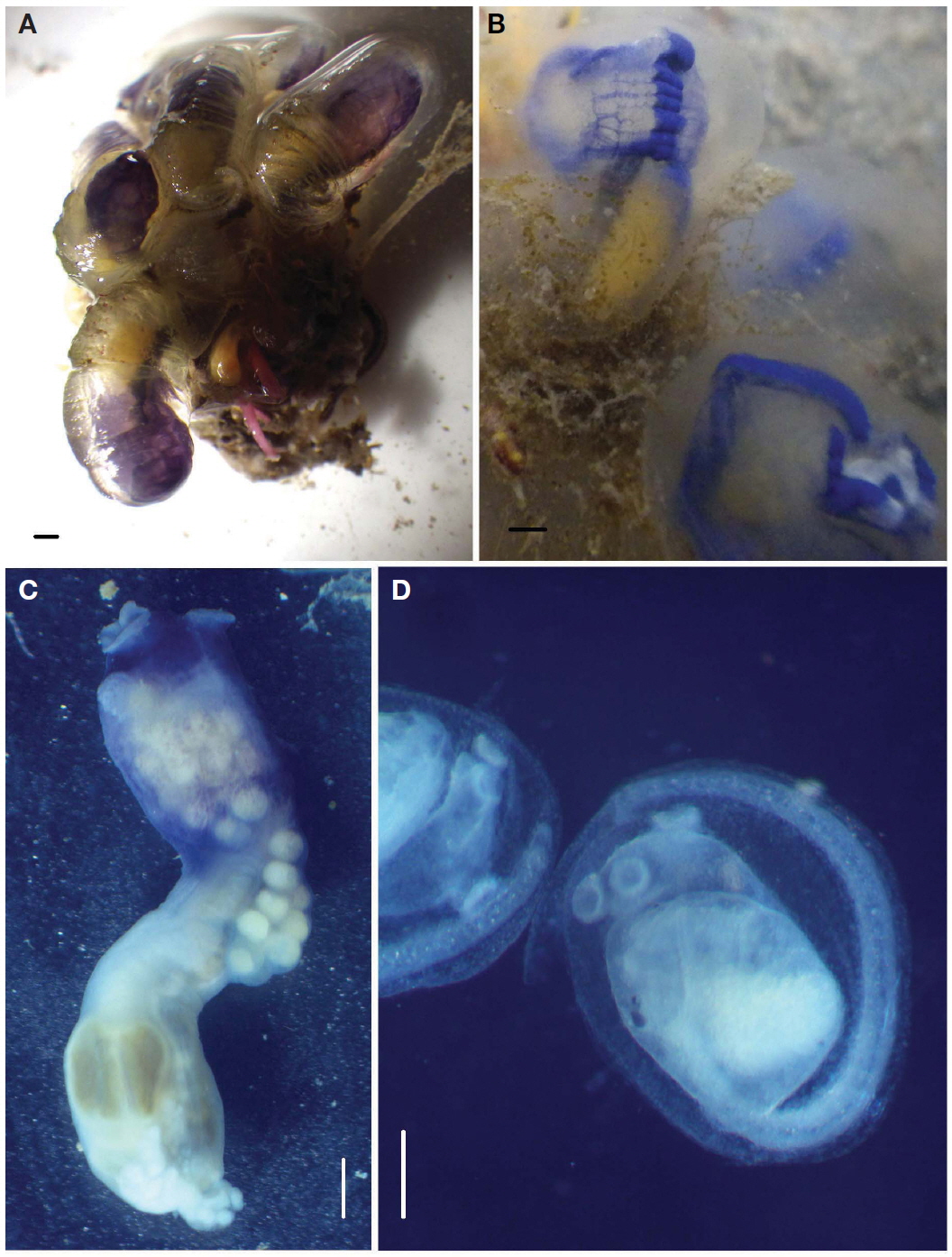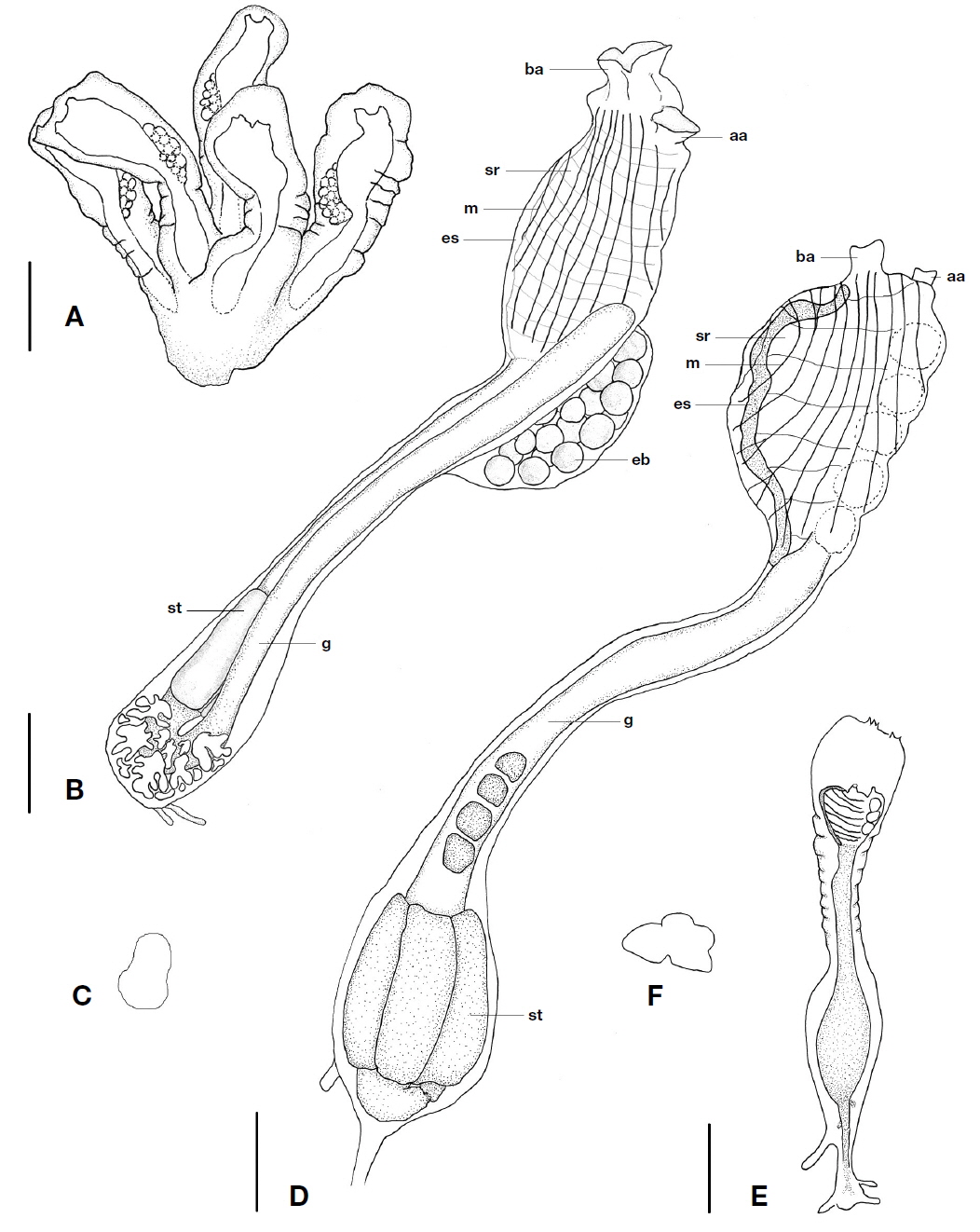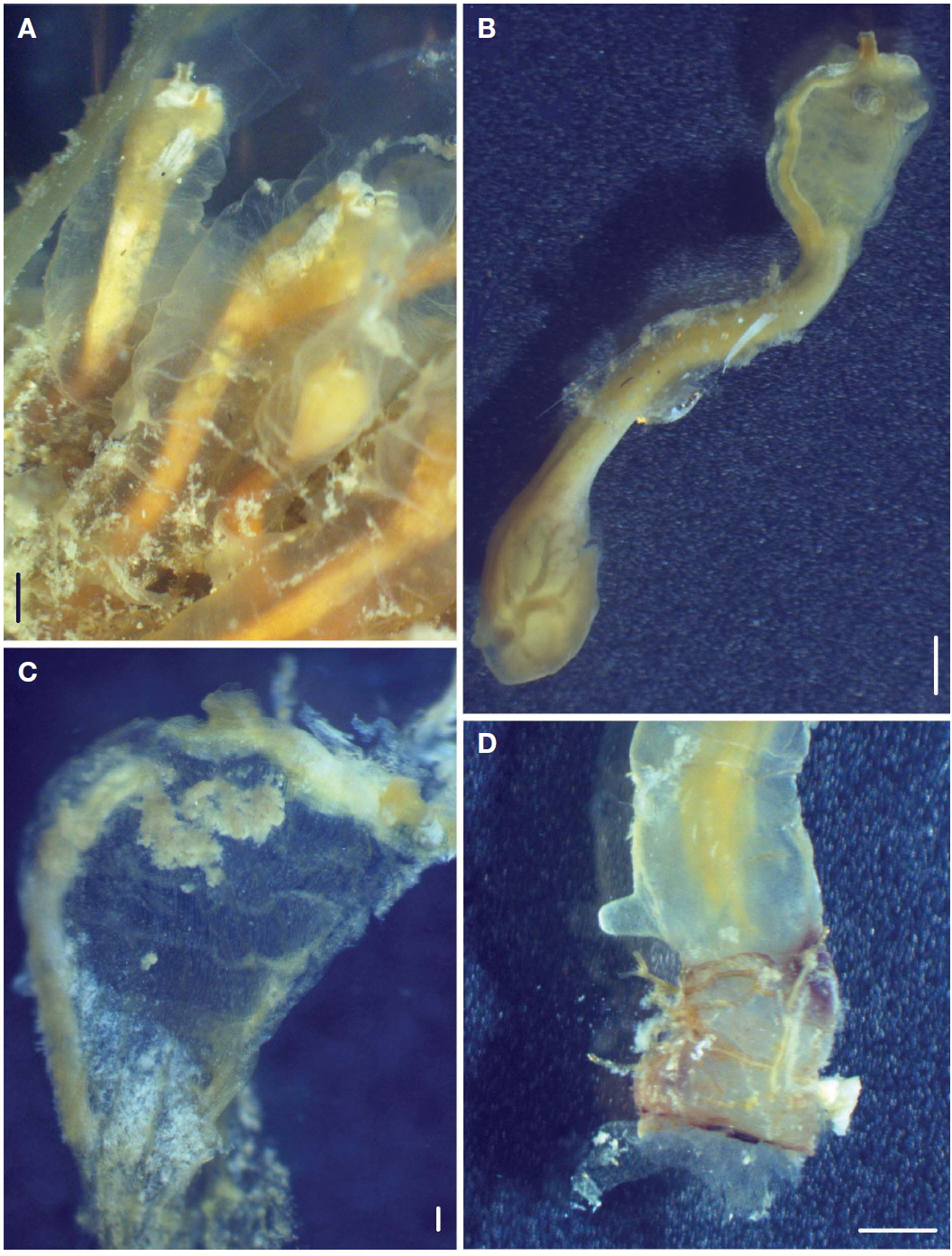



Colonial ascidians, Clavelina elegans (
The genus
Among the 47 recorded species of Genus
Materials of
Collected specimens were anesthetized with menthol for 8 h, and then fixed in 4% formalin with seawater. Materials were kept in the solution which was composed of 1% chromic acid and 50% acetic acid in the ratio of 1 to 10 for a day and then they were replaced into the solution of 1% chromic acid for a few hours before dissecting.
For identification, each specimen was examined for morphological characteristics such as colony organization, thoracic muscles formula, stigmata, stomach, gonad, larvae and coloration under stereomicroscopes (SZX7; Olympus, Tokyo, Japan). The color of each part was recorded with a color code based on the color chart (Pantone color formula guide 747XR). Images of the collected living
The systematic scheme of ascidians was adopted from Kott (1990), Monniot and Monniot (2001), and Sanamyan (2013a, 2013b). Specimens are deposited in Natural History Museum, Ewha Womans University, Seoul, Korea (EWNHMAS 1-3).
Order Aplousobranchia Lahille, 1886
Family Clavelinidae Forbes and Hanley, 1848
Genus
Material examined. Two colonies with 9 zooids and 5 zooids, Korea, Jeju-do, Beomseom, 30 May 2013, Seo SY (EWNHMAS 1-2), 17 m deep by SCUBA diving.
Diagnosis. Zooids partially embedded in common stalk. Small zooid. Cobalt blue color with white patch around aperture. Longitudinal thoracic muscles.
Description. Two colonies consist respectively of 5 and 9 zooids crowded on a common basal mass up to 6.2 mm in thickness. Zooids fanning out from the upper surface of basal mass in which posterior ends of zooids embedded. Long portion (12.5-15.7 mm) of zooids separated, while the proximal part (1.2-2.2 mm) of zooids embedded in common basal mass (Figs. 1A, 2A).
Zooidal test fragile and transparent, while test of the stalk somewhat tough and whitish translucent. Zooid transparent with dark cobalt blue pigments and white patch in living. Dark cobalt blue pigments (Pantone 286C) in band along each side of endostyle, on dorsal midline, and around branchial apertures in living. White patch U shaped and inside dark blue patch between both apertures in living (Fig. 1B). Zooids become purple blue (Pantone 2755C) in formalin solution (Fig. 1C).
Zooids small 12.9 mm long on average, up to 14.1 mm long in contracted condition. Thorax 3.8-5.4 mm long and 2.0-3.8 mm wide, while abdomen 6.9-8.7 mm long and 1.4-1.7 mm wide. Thorax shorter than abdomen in both extracted zooids and contracted zooids (Figs. 1C, 2B).
Strong longitudinal muscles extend along length of thorax. Muscles formula 1-2E5-7B2D=8-11.
Both apertures open at upper terminal of thorax. Branchial apertures have two lips. Number of tentacles 9-10 alternated large and small. Opening of neural gland simple and longitudinal slit. Dorsal languet fine pointed tongue shape. 14-16 stigmata rows of 46-52 stigmata. Transverse vessels provided each with a well-developed membrane.
Oesophageal neck more or less long, narrow, and occupy about two thirds of total length of abdomen in zooid.
No prestomach and large posterior stomach occurs at posterior end of descending limb of gut loop. Pear-shaped stomach have smooth surface with a few rather distinct plication (Figs. 1C, 2C). Anus opens at level as high as posterior three stigmata row. Atrial apertures have smooth border (Fig. 2B).
Gonads usual form in gut loop posterior to stomach. Male follicles spill out over posterior end of gut loop obscuring it. Brood pouch extends across posterior end of right side of thorax from postero-dorsal corner and have 27-48 embryos. Embryos complete their development in peribranchial cavity. Larvae yellow in living (Pantone 114C) and small; trunk 0.63-0.69 mm long; tail three quarters of distance around trunk. Larvae have an ocellus and an otolith. Frontal plate well developed. Three adhesive organs lie on expanded lobes from frontal plate. Two on its left upwards while one on its right upwards (Fig. 1D).
Distribution. Pacific Ocean: Korea (Beomseom, Jeju-do), Japan (Sagami Bay, Amakusa rooky reef, Minabe).
Remarks. The present species,
This species very resembles Amakusa species of Tokioka and Nishikawa (1976) in colony organization, zooid size, thoracic muscles, ciliate groove, stomach surface, stomach location and brood pouch. They slightly differ in that this species has 14-16 stigmata rows of 46-52 stigmata but Amakusa species 17-18 stigmata rows of 50-60 stigmata. Tokioka and Nishikawa (1976) did not describe white patches in living zooid from Amakusa.
The present species very resembles
This species resembles
Material examined. One colony with 50 zooids, Korea, Jeju-do, Chagwido, 8 Jun 2001, Song JI (EWNHMAS 3), by SCUBA diving.
Diagnosis. Zooids connected by basal stolon. Small zooid. Yellow color. Longitudinal thoracic muscles.
Description. Fifty zooids independently attached to an oyster shell by stolon and form social colony of 30-40 mm in extent (Figs. 2E, 3D). Some hydrozoans grow along marginal attachment part of zooidal test. Zooidal test thin, gelatinous, colorless and very transparent so that mantle body wholly seen through it (Fig. 3A). Bright orange pigments (Pantone 128U) in band along each side of endostyle and on dorsal midline in formalin solution (Fig. 3B).
Zooids small 14 mm long on average, up to 17 mm long in contracted condition. Thorax 4 mm long and 2-2.8 mm wide, while abdomen 10 mm long and 1.2-2.1 mm wide. Thorax shorter than abdomen in extracted zooids and contracted zooids. Thorax occupies one fourth of whole body, while abdomen occupies three-fourths of it in preserved specimen (Figs. 2D, 3B).
Nearly longitudinal muscles extend along length of thorax. Muscles formula 4-5E3B3D=10-11.
Branchial aperture opens at terminal of thorax and atrial aperture subterminal. Anus opens at level as high as posterior one stigmata row. Branchial aperture short moderately with plain margin. Atrial apertures have smooth border. Number of tentacles 12 alternated large and small. Opening of neural gland small, elliptical and slightly transverse. Dorsal languet ribs. 8-10 stigmata row of up to 40 stigmata. Stigmata row around middle of branchial sac have largest number of stigmata (Fig. 3C). Transverse vessels provided each with a well-developed membrane.
Oesophageal neck very long, narrow, and occupy about one half of total length of abdomen in zooid.
Large posterior stomach occupy from one fourth to one fifth of abdomen, occurs at posterior end of descending limb of gut loop. Stomach globular, has 4-5 short striations on the right side of surface, and distinctly represented by thickened wall on inner surface (Fig. 2F).
Gonads occupy left side of intestinal loop posterior to the pyloric end of stomach. Ovarian eggs 0.75 mm in diameter at maximum.
Distribution. Pacific Ocean: Korea (Chagwido, Jeju-do), Japan (West of Shimonda).
Remarks. The present species,
This species most closely resembles
This species resembles


